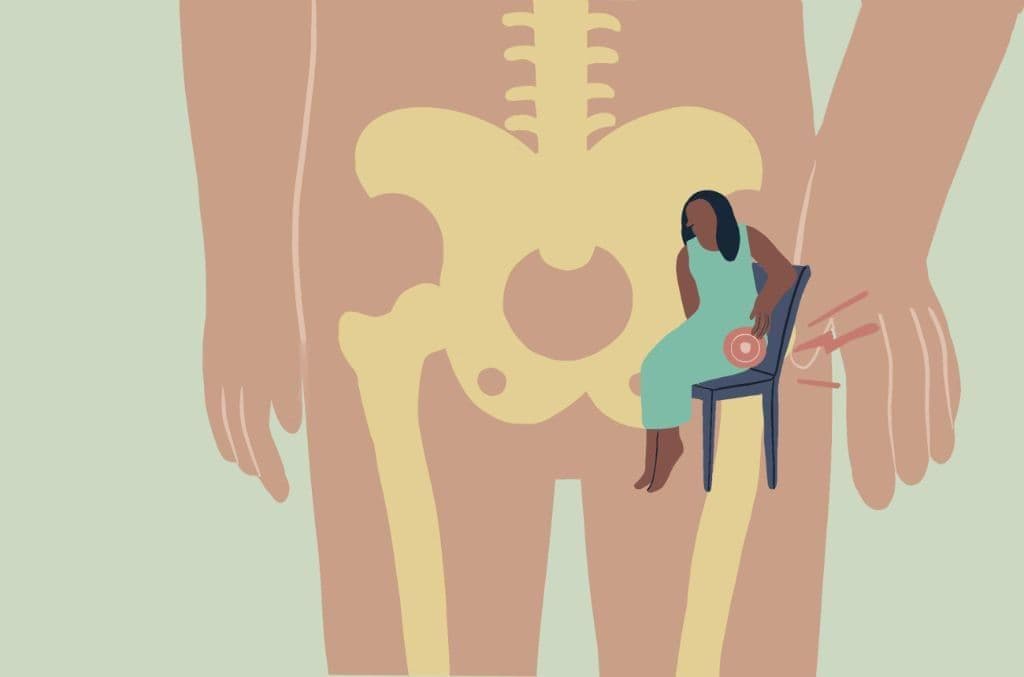This blog is compiled by Athira Krishnan, a content writer for Proactive For Her.
What are the causes of hip pain?
Hip pain can be caused by some underlying conditions or pain in surrounding areas
- Arthritis - Arthritis is the swelling and tenderness of one or more of your joints. The main symptoms of arthritis are joint pain and stiffness. Arthritis is one of the most common causes of pain in the hip.
- Bursitis - This is a condition that affects the fluid-filled sacs called bursae - that act as cushioning for the joints, in which the bursae become inflamed. The most common locations for bursitis are in the shoulder, elbow and hip.
- Tendonitis - A condition in which the tendon (tissue connecting muscle to bone) becomes inflamed.
- Excessive strain due to prolonged periods of sitting and bad posture
- Sciatica - Sciatica refers to the pain along the sciatic nerve, which runs down the legs from the lower back. This pain can also radiate to the hip.
- Pregnancy - In preparation for childbirth, the hormone relaxin is released which relaxins the ligaments in the pelvis and widens the cervix. Post delivery, the muscles and ligaments are loosened and may cause hip pain.
What are the symptoms?
- In most cases, you might experience pain in your hip joint, groin, thigh or knee
- In cases of sciatica or a nerve condition, you may experience a tingling or a numb sensation in your hip area.
- Due to the pain, you may experience a reduced range of motion.
When should you see a doctor?
You should see your doctor when -
- the pain is sudden and intense
- an older injury gets triggered
- you observe a deformation or bleeding in the area
- there is a popping noise when you move
- you are unable to put any weight on that side
How is hip pain treated?
At home, you can treat hip pain with ice packs and low impact exercises.
There are two categories of low impact exercises - stretching and strengthening exercises.
- Stretching exercises are important as they improve mobility and they relieve tightness of muscles around the hip joint. It also helps to ease hip pain by allowing the joint to move fully, thereby improving functional mobility and decreasing compensatory movements (movements used habitually to achieve functional motor skills when a normal movement pattern hasn’t been established or is unavailable)
- Strengthening exercises are important since hip pain decreases muscle activation around the hip, thereby causing the muscles to lose their strength.
What are some stretching exercises?
1. Hamstring stretch
While stretching your hamstring, you might feel a pull/stretch behind your thigh. If the pain is intense, stop and consult a physiotherapist moving forward as they will guide you on the proper form and position required for exercises.
- Lie on your back with your legs straight out
- Bend one knee, place both palms behind your knee and slowly straighten your knee all the way
- Hold in this position for 30 seconds and slowly release
- Repeat this 3 times, each side.
2. Hip-flexor stretch
- Start out in a lunge position. (You can place a chair in front of you for support)
- Bend your front leg till your thigh is parallel to the floor, while making sure your feet are placed flat on the floor. Slowly bring your back knee down, till it touches the floor.
- In this position, push your hips forward gently until you feel a stretch
- Hold in this position for 30 seconds and repeat with the other leg.
3. Iliotibial band stretch
The Iliotibial band is a thick band of tissue that courses from your lateral hip to your lateral knee.
- Lie on your side. The side you wish to stretch should be on top.
- While keeping your bottom knee bent for stability, reach back and grab the ankle of your upper leg and bend that knee. You should be able to feel a stretch in the front of your thigh.
- While keeping your knees bent, gently rest the foot of your bottom leg on top of your upper knee. Using that foot, try and slowly pull your upper knee towards the floor. You should feel a pulling sensation on the side of your knee cap.
- Hold in this position for 30 seconds, release and repeat.
4. Figure four stretch
- Lie on your back
- Bend your legs with your feet flat on the floor
- Place your left ankle over your right knee
- Clasp your hands behind your right knee and slowly pull it towards your chest
- Hold in this position for 30 seconds and release. Repeat once more and perform this exercise on the other side.
What are some strengthening exercises?
1. Straight leg raising
- Lie on your back with one knee bent and the other knee straight
- Tighten your thigh muscles of the straightened out leg, engage your core and lift the leg about 12 inches off the ground
- Hold in this position for 3 seconds and then slowly lower your leg
- Repeat 5-7 times and switch sides.
2. Bridging
- Lie on your back with both knees bent and feet flat on the floor
- Engage your core and slowly lift your buttocks by pressing your heels onto the floor
- Flex your buttock muscles as your lift them
- Lift your hips until your knees , hips and back are in a straight line
- Hold in this position for 30 seconds and slowly lower your body.
3. Side-lying leg raise (variation of straight leg raise)
- Lie on your side while keeping your lower leg slightly bent.
- Engage your core and raise your top leg without moving the rest of your body. Remember to keep the leg straight.
- Hold in this position for 2 seconds and repeat 5-10 times depending on your comfort level.
In conclusion - Arthritis is the most common cause of hip pain, especially in women. It is recommended to consult a physiotherapist, who will then prescribe exercises. Performing these exercises regularly will greatly reduce your pain, increase your mobility and help you gain back the strength in your muscles.
Disclaimer - This information is provided for educational purposes and should not be construed as medical advice. Please consult with your healthcare practitioners before undertaking any changes in your diet or adding supplements.
Proactive For Her is a digital clinic for women, offering accessible, personalized, and confidential healthcare solutions. We offer products and services for out-patient health concerns of Indian women, across their lifetime - from puberty to pregnancy to menopause. To know more on the sexual and reproductive health of women, visit https://www.proactiveforher.com/

